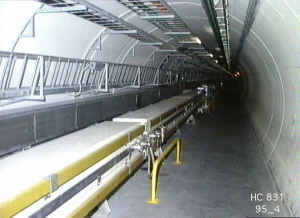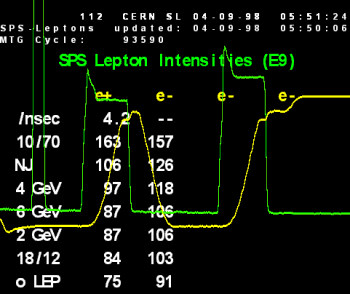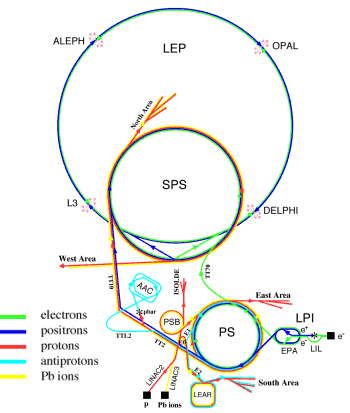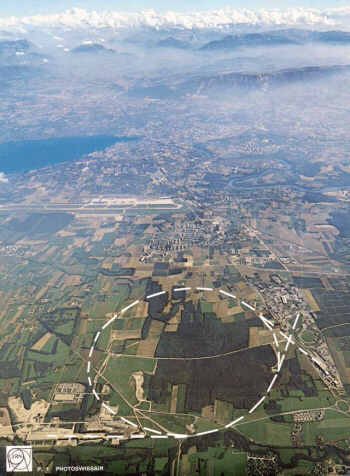Particle Accelerators

The high-energy physics counterpart of the Hubble Space Telescope is the particle accelerator, which can be thought of as a sort of microscope for exploring the realm of the quantum. They vary in size and configuration from the earliest cyclotrons to the linear tunnels to the great ring accelerators of today.
Modern accelerators use huge rings of superconducting magnets which accelerate charged particles to relativistic speeds (speeds close to the speed of light). The beams are then collided with target particles, which can be stationary sheets of lead or another particle beam which has been accelerated in the opposite direction. The resulting scattering of particles is recorded and analyzed. In general, the higher the energy achieved, defined by the the velocity of the beam and the mass of the particles, the more powerful the view into the subatomic domain. The most powerful accelerator planned to date is the LHC project at CERN, the European Laboratory for Particle Physics.
The Large Hadron Collider (LHC ) is an accelerator which brings protons into head-on collision at higher energies (14 TeV) than ever achieved before to allow scientists to penetrate still further into the structure of matter and recreate the conditions prevailing in the Universe just 10-12 seconds after the "Big Bang" when the temperature was 1016 degrees.

The CERN Accelerators
CERN, located near Geneva in Switzerland and France, is one of the world's largest scientific laboratories and an outstanding example of international collaboration of its many member states.
(The acronym CERN comes from the earlier French title: Conseil European pour la Recherche Nucleaire)
CERN exists primarily to provide European physicists with accelerators that meet research demands at the limits of human knowledge. In the quest for higher interaction energies, the Laboratory has played a leading role in developing colliding beam machines. Notable "firsts" were the Intersecting Storage Rings (ISR) proton-proton collider commissioned in 1971, and the proton-antiproton collider at the Super Proton Synchrotron (SPS), which came on the air in 1981 and produced the massive W and Z particles two years later, confirming the unified theory of electromagnetic and weak forces.
The Large Electron-Positron Collider (LEP) has provided measurements unsurpassed in quantity and quality which are testing our best description of sub-atomic Nature, the Standard Model, to one part in a thousand. LEP data are so accurate that they are sensitive to phenomena that occur at energies beyond those of the machine itself; rather like delicate measurement of earthquake tremors far from an epicenter. This gives us a "preview" of exciting discoveries that may be made at higher energies, and allow us to calculate the parameters of a machine that can make these discoveries. All evidence indicates that new physics, and answers to some of the most profound questions of our time, lie at energies around 1 TeV (1 TeV = 1,000 GeV).
To look for this new physics, the newest research instrument in Europe's particle physics armory is the Large Hadron Collider (LHC). In keeping CERN's cost-effective strategy of building on previous investments, it is designed to share the 27-kilometer LEP tunnel, and be fed by existing particle sources and pre-accelerators. A challenging machine, the LHC uses the most advanced superconducting magnet and accelerator technologies ever employed. LHC experiments are, of course, being designed to look for theoretically predicted phenomena. However, they must also be prepared, as far as is possible, for surprises. This will require great ingenuity on the part of the physicists and engineers.
The LHC is a remarkably versatile accelerator. It can collide proton beams with energies around 7-on-7 TeV and beam crossing points of unsurpassed brightness, providing the experiments with high interaction rates. It can also collide beams of heavy ions such as lead with a total collision energy in excess of 1,250 TeV, about thirty times higher than at the Relativistic Heavy Ion Collider (RHIC) under construction at the Brookhaven Laboratory in the US. Joint LHC/LEP operation can supply proton-electron collisions with 1.5 TeV energy. The research, technical and educational potential of the LHC and its experiments is enormous.

LEP: Large Electron-Positron Collider
SPS: Super Proton Synchrotron
AAC: Antiproton Accumulator Complex
ISOLDE: Isotope Separator Online Device
PSB: Proton Synchrotron Booster
PS : Proton Synchrotron LPI: Lep Pre-Injector
EPA: Electron Positron Accumulator
LIL: Lep Injector Linac
LINAC2: Linear Accelerator 2
LINAC3: Linear Accelerator 3
LEAR: Low Energy Antiproton RingRudolf Ley, PS Division, CERN




